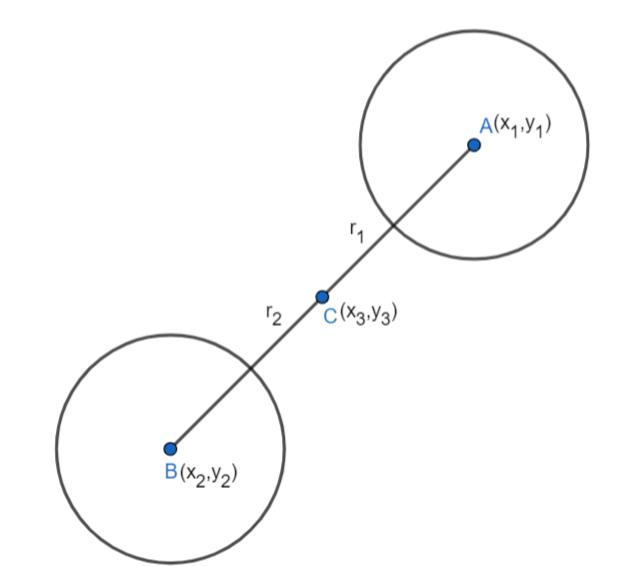
The internal center of similitude of two circles \[{{(x-3)}^{2}}+{{(y-2)}^{2}}=9,{{(x+5)}^{2}}+{{(y+6)}^{2}}=9\] is
\[\begin{align}
& \text{(A) (-1,-2)} \\
& \text{(B) (-2,-1)} \\
& \text{(C) (3,2)} \\
& \text{(D) (-5,-6)} \\
\end{align}\]
Answer
583.8k+ views
Hint: We know that if \[P({{x}_{1}},{{y}_{1}})\] and \[Q({{x}_{2}},{{y}_{2}})\] are divided by \[R({{x}_{3}},{{y}_{3}})\] in the ratio \[m:n\] internally if \[{{x}_{3}}=\dfrac{m{{x}_{2}}+n{{x}_{1}}}{m+n},{{y}_{3}}=\dfrac{m{{y}_{2}}+n{{y}_{1}}}{m+n}\]. We should know that if the internal centre of similitude of two circles \[{{(x-{{x}_{1}})}^{2}}+{{(y-{{y}_{1}})}^{2}}=r_{1}^{2},{{(x-{{x}_{2}})}^{2}}+{{(y-{{y}_{2}})}^{2}}=r_{2}^{2}\] is \[A({{x}_{3}},{{y}_{3}})\], then \[A({{x}_{3}},{{y}_{3}})\] divides the centre of two circles in the ratio \[{{r}_{1}}:{{r}_{2}}\]. By using this concept, we can find the internal centre of similitude of \[{{(x-3)}^{2}}+{{(y-2)}^{2}}=9,{{(x+5)}^{2}}+{{(y+6)}^{2}}=9\].
Complete step by step solution:
We know that if the internal centre of similitude of two circles \[{{(x-{{x}_{1}})}^{2}}+{{(y-{{y}_{1}})}^{2}}=r_{1}^{2},{{(x-{{x}_{2}})}^{2}}+{{(y-{{y}_{2}})}^{2}}=r_{2}^{2}\] is \[A({{x}_{3}},{{y}_{3}})\], then \[A({{x}_{3}},{{y}_{3}})\] divides the centre of two circles in the ratio \[{{r}_{1}}:{{r}_{2}}\] .

In the question, we were given two circles \[{{(x-3)}^{2}}+{{(y-2)}^{2}}=9,{{(x+5)}^{2}}+{{(y+6)}^{2}}=9\].
Now let us compare \[{{(x-3)}^{2}}+{{(y-2)}^{2}}=9\] with \[{{(x-{{x}_{1}})}^{2}}+{{(y-{{y}_{1}})}^{2}}=r_{1}^{2}\].
We get
\[\begin{align}
& {{x}_{1}}=3....(1) \\
& {{y}_{1}}=2.....(2) \\
& {{r}_{1}}^{2}=9 \\
& \Rightarrow {{r}_{1}}=3....(3) \\
\end{align}\]
Now let us compare \[{{(x+5)}^{2}}+{{(y+6)}^{2}}=9\] with \[{{(x-{{x}_{2}})}^{2}}+{{(y-{{y}_{2}})}^{2}}=r_{2}^{2}\].
We get
\[\begin{align}
& {{x}_{2}}=-5...(4) \\
& {{y}_{2}}=-6.....(5) \\
& {{r}_{2}}^{2}=9 \\
& \Rightarrow {{r}_{2}}=3....(6) \\
\end{align}\]
We know that the internal centre of similitude divides the line joining the centre in the ratio \[{{r}_{1}}:{{r}_{2}}\] internally.
So, we get the centre of \[{{(x-3)}^{2}}+{{(y-2)}^{2}}=9\] is \[{{C}_{1}}(3,2)\] and radius of \[{{(x-3)}^{2}}+{{(y-2)}^{2}}=9\] is equal to 3.
In the similar manner, we get centre of \[{{(x+5)}^{2}}+{{(y+6)}^{2}}=9\] is \[{{C}_{2}}(-5,-6)\] and radius of \[{{(x+5)}^{2}}+{{(y+6)}^{2}}=9\] is equal to 3.
So, it is clear that \[A({{x}_{3}},{{y}_{3}})\] divides \[{{C}_{1}}(3,2)\] and \[{{C}_{2}}(-5,-6)\] in the ratio \[3:3\] internally.
We know that if \[P({{x}_{1}},{{y}_{1}})\] and \[Q({{x}_{2}},{{y}_{2}})\] are divided by \[R({{x}_{3}},{{y}_{3}})\] in the ratio \[m:n\] internally if \[{{x}_{3}}=\dfrac{m{{x}_{2}}+n{{x}_{1}}}{m+n},{{y}_{3}}=\dfrac{m{{y}_{2}}+n{{y}_{1}}}{m+n}\].
By using this concept, we get
\[\begin{align}
& \Rightarrow {{x}_{3}}=\dfrac{m{{x}_{2}}+n{{x}_{1}}}{m+n} \\
& \Rightarrow {{x}_{3}}=\dfrac{3(-5)+3(3)}{3+3} \\
& \Rightarrow {{x}_{3}}=-1.....(7) \\
\end{align}\]
In the similar way, we get
\[\begin{align}
& \Rightarrow {{y}_{3}}=\dfrac{m{{y}_{2}}+n{{y}_{1}}}{m+n} \\
& \Rightarrow {{y}_{3}}=\dfrac{3(-6)+3(2)}{3+3} \\
& \Rightarrow {{y}_{3}}=-2.....(8) \\
\end{align}\]
From equation (7) and equation (8), we get the coordinates of internal centre of similitude is \[(-1,-2)\].
Hence, option A is correct.
Note: Some students have a misconception that if \[P({{x}_{1}},{{y}_{1}})\] and \[Q({{x}_{2}},{{y}_{2}})\] are divided by \[R({{x}_{3}},{{y}_{3}})\] in the ratio \[m:n\] internally if \[{{x}_{3}}=\dfrac{m{{x}_{2}}-n{{x}_{1}}}{m-n},{{y}_{3}}=\dfrac{m{{y}_{2}}-n{{y}_{1}}}{m-n}\]. But we know that the given coordinates are the coordinates obtained if \[R({{x}_{3}},{{y}_{3}})\] is get divided in the ratio \[m:n\] externally. But if this misconception is followed, then we will get the external centre of similitude. But we want internal central similitude. So, this misconception hasto be avoided.
Complete step by step solution:
We know that if the internal centre of similitude of two circles \[{{(x-{{x}_{1}})}^{2}}+{{(y-{{y}_{1}})}^{2}}=r_{1}^{2},{{(x-{{x}_{2}})}^{2}}+{{(y-{{y}_{2}})}^{2}}=r_{2}^{2}\] is \[A({{x}_{3}},{{y}_{3}})\], then \[A({{x}_{3}},{{y}_{3}})\] divides the centre of two circles in the ratio \[{{r}_{1}}:{{r}_{2}}\] .

In the question, we were given two circles \[{{(x-3)}^{2}}+{{(y-2)}^{2}}=9,{{(x+5)}^{2}}+{{(y+6)}^{2}}=9\].
Now let us compare \[{{(x-3)}^{2}}+{{(y-2)}^{2}}=9\] with \[{{(x-{{x}_{1}})}^{2}}+{{(y-{{y}_{1}})}^{2}}=r_{1}^{2}\].
We get
\[\begin{align}
& {{x}_{1}}=3....(1) \\
& {{y}_{1}}=2.....(2) \\
& {{r}_{1}}^{2}=9 \\
& \Rightarrow {{r}_{1}}=3....(3) \\
\end{align}\]
Now let us compare \[{{(x+5)}^{2}}+{{(y+6)}^{2}}=9\] with \[{{(x-{{x}_{2}})}^{2}}+{{(y-{{y}_{2}})}^{2}}=r_{2}^{2}\].
We get
\[\begin{align}
& {{x}_{2}}=-5...(4) \\
& {{y}_{2}}=-6.....(5) \\
& {{r}_{2}}^{2}=9 \\
& \Rightarrow {{r}_{2}}=3....(6) \\
\end{align}\]
We know that the internal centre of similitude divides the line joining the centre in the ratio \[{{r}_{1}}:{{r}_{2}}\] internally.
So, we get the centre of \[{{(x-3)}^{2}}+{{(y-2)}^{2}}=9\] is \[{{C}_{1}}(3,2)\] and radius of \[{{(x-3)}^{2}}+{{(y-2)}^{2}}=9\] is equal to 3.
In the similar manner, we get centre of \[{{(x+5)}^{2}}+{{(y+6)}^{2}}=9\] is \[{{C}_{2}}(-5,-6)\] and radius of \[{{(x+5)}^{2}}+{{(y+6)}^{2}}=9\] is equal to 3.
So, it is clear that \[A({{x}_{3}},{{y}_{3}})\] divides \[{{C}_{1}}(3,2)\] and \[{{C}_{2}}(-5,-6)\] in the ratio \[3:3\] internally.
We know that if \[P({{x}_{1}},{{y}_{1}})\] and \[Q({{x}_{2}},{{y}_{2}})\] are divided by \[R({{x}_{3}},{{y}_{3}})\] in the ratio \[m:n\] internally if \[{{x}_{3}}=\dfrac{m{{x}_{2}}+n{{x}_{1}}}{m+n},{{y}_{3}}=\dfrac{m{{y}_{2}}+n{{y}_{1}}}{m+n}\].
By using this concept, we get
\[\begin{align}
& \Rightarrow {{x}_{3}}=\dfrac{m{{x}_{2}}+n{{x}_{1}}}{m+n} \\
& \Rightarrow {{x}_{3}}=\dfrac{3(-5)+3(3)}{3+3} \\
& \Rightarrow {{x}_{3}}=-1.....(7) \\
\end{align}\]
In the similar way, we get
\[\begin{align}
& \Rightarrow {{y}_{3}}=\dfrac{m{{y}_{2}}+n{{y}_{1}}}{m+n} \\
& \Rightarrow {{y}_{3}}=\dfrac{3(-6)+3(2)}{3+3} \\
& \Rightarrow {{y}_{3}}=-2.....(8) \\
\end{align}\]
From equation (7) and equation (8), we get the coordinates of internal centre of similitude is \[(-1,-2)\].
Hence, option A is correct.
Note: Some students have a misconception that if \[P({{x}_{1}},{{y}_{1}})\] and \[Q({{x}_{2}},{{y}_{2}})\] are divided by \[R({{x}_{3}},{{y}_{3}})\] in the ratio \[m:n\] internally if \[{{x}_{3}}=\dfrac{m{{x}_{2}}-n{{x}_{1}}}{m-n},{{y}_{3}}=\dfrac{m{{y}_{2}}-n{{y}_{1}}}{m-n}\]. But we know that the given coordinates are the coordinates obtained if \[R({{x}_{3}},{{y}_{3}})\] is get divided in the ratio \[m:n\] externally. But if this misconception is followed, then we will get the external centre of similitude. But we want internal central similitude. So, this misconception hasto be avoided.
Recently Updated Pages
Master Class 11 Economics: Engaging Questions & Answers for Success

Master Class 11 English: Engaging Questions & Answers for Success

Master Class 11 Social Science: Engaging Questions & Answers for Success

Master Class 11 Biology: Engaging Questions & Answers for Success

Class 11 Question and Answer - Your Ultimate Solutions Guide

Master Class 11 Business Studies: Engaging Questions & Answers for Success

Trending doubts
What is meant by exothermic and endothermic reactions class 11 chemistry CBSE

What are Quantum numbers Explain the quantum number class 11 chemistry CBSE

What is periodicity class 11 chemistry CBSE

Explain zero factorial class 11 maths CBSE

What is a periderm How does periderm formation take class 11 biology CBSE

Mention the basic forces in nature class 11 physics CBSE




